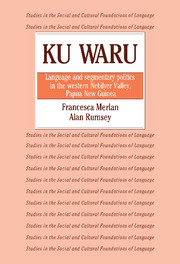Book contents
- Frontmatter
- Contents
- List of illustrations
- List of tables
- List of abbreviations
- Preface and acknowledgments
- 1 Introduction
- 2 The setting
- 3 Some aspects of Ku Waru segmentary sociality
- 4 Ceremonial exchange and marriage in the western Nebilyer Valley
- 5 Some linguistic structures of segmentary politics
- 6 Warfare compensation payment to Laulku: an analysis
- 7 Compensation at Palimung and the Kulka women's club
- 8 The events in perspective
- 9 Perspectives on ‘event’
- Appendix A Transcript of proceedings at Kailge on July 24, 1983
- Appendix B Grammatical sketch of Bo Ung, Ku Waru dialect
- Appendix C The conduct of warfare
- Appendix D Ku Waru metalinguistic expressions
- Chapter notes
- Glossary
- References
- Index
- Plate section
5 - Some linguistic structures of segmentary politics
Published online by Cambridge University Press: 30 December 2009
- Frontmatter
- Contents
- List of illustrations
- List of tables
- List of abbreviations
- Preface and acknowledgments
- 1 Introduction
- 2 The setting
- 3 Some aspects of Ku Waru segmentary sociality
- 4 Ceremonial exchange and marriage in the western Nebilyer Valley
- 5 Some linguistic structures of segmentary politics
- 6 Warfare compensation payment to Laulku: an analysis
- 7 Compensation at Palimung and the Kulka women's club
- 8 The events in perspective
- 9 Perspectives on ‘event’
- Appendix A Transcript of proceedings at Kailge on July 24, 1983
- Appendix B Grammatical sketch of Bo Ung, Ku Waru dialect
- Appendix C The conduct of warfare
- Appendix D Ku Waru metalinguistic expressions
- Chapter notes
- Glossary
- References
- Index
- Plate section
Summary
In this chapter we will discuss some linguistic structures through which exchange events are constituted. The emphasis will be on the traditional forms of men's oratory – the structural patterns themselves. This will provide essential background for the following two chapters (6 and 7), where we will be concerned with situated uses of these forms, basing our analysis on transcripts of speeches made at three interrelated exchange events.
In trying to carry out the main task of this chapter – to describe a particular set of linguistic resources – there are at least two different ways in which we could proceed. One would be to start with given linguistic patterns or types, such as the indigenously recognized genre of ung eke ‘bent’ (i.e. figurative) speech, identify various instances of each type, and compare the uses of them across the range of contexts in which they are found to occur. This is the approach taken by Andrew Strathern in his (1975) study of the Melpa equivalent of Nebilyer ung eke, which he calls ‘veiled speech’. An alternative approach, which we will follow here, is to start with full transcripts of what was said at particular speech events of the relevant sort – public exchange events – identify particular linguistic devices which are used at them, to look for possible interrelations among the various devices and between the devices and their contexts of use.
The three events which comprise the bulk of our sample are compensation events which took place in July and August 1983, arising from the Marsupial Road War of 1982 (sections 1.1 and 3.2.2).
- Type
- Chapter
- Information
- Ku WaruLanguage and Segmentary Politics in the Western Nebilyer Valley, Papua New Guinea, pp. 88 - 121Publisher: Cambridge University PressPrint publication year: 1991

